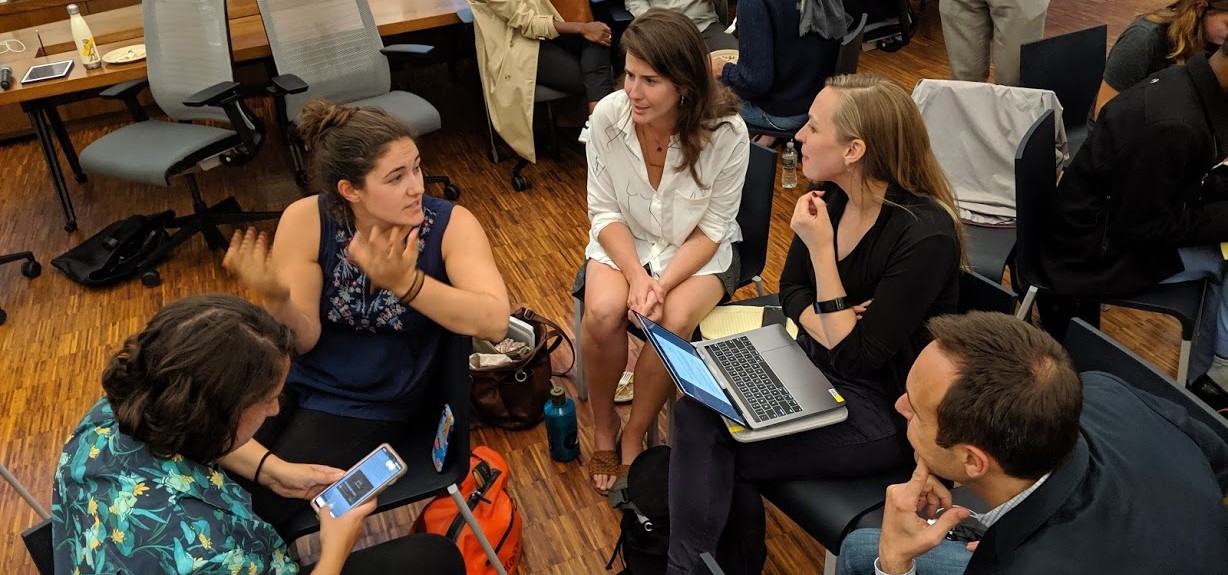
The Earth Institute’s Climate and Sustainability Communications Network is a sharing, learning and doing community of researchers, scholars, students, staff and other Columbians seeking communication impact addressing climate and sustainability challenges. This network, reaching from undergraduates to department chairs, will span campuses, programs and disciplines and, over time, extend outward through alumni and the university’s partners worldwide.
The network is a key component of the Earth Institute’s new Initiative on Communication and Sustainability, launched in July. As Earth Institute director Alex Halliday said, “We want to tackle specific climate and sustainability challenges where the impediment to progress is an information gap, a paralyzed conversation, or a missing connection between disciplines or sectors of society.”
The relationships we build will ultimately shape curricula, enhance public communication of research to audiences at all levels and build Columbia’s reputation as a leader in approaching the new communication environment with the same exploratory energy and rigor we apply to scientific frontiers.
Campus connectivity will turn knowledge into action in several ways. We’ll organize events, workshops, training and mentoring opportunities that can result in more effective connections between scientists and the media or foster direct public engagement by scientists and scholars, aided, where needed, by Columbia’s professional communication staff.
One recent example came as Hurricane Dorian, at Category 5 strength, churned to a halt over the Bahamas. A New York Times editor reached out to Kevin Krajick of the Earth Institute communications staff and the result was a couple of much-read pieces by hurricane expert Adam Sobel. The result represents a new potential standing feature at The Times through which Earth Institute scientists and scholars can answer readers’ questions.
Meetings with the public or between experts can be designed in ways that foster respect and understanding, if not agreement. This practice can smooth the path to more adaptive, equitable communities, more effective education, less contentious politics, and more. Just ask the folks at Columbia’s Difficult Conversations Lab for insights. They’re based at Teacher’s College but part of the Earth Institute family. This network will connect you with them and dozens of other hubs around Columbia and, ultimately, around the world.
The network will connect arts and sciences. There’s enormous potential overlap, as when the Pennsylvania-based artist Stacy Levy took a visual cue from an icon of 1970s art, Robert Smithson’s Spiral Jetty in the Great Salt Lake, and created floating, functional living variants she calls “Spiral Wetlands” -- which actively remediate waters overloaded with nutrients. There can be music in this network. In 2013, a conversation between an undergraduate student and geography professor at the University of Minnesota resulted in the student’s cello composition turning 133 years of NASA/GISS temperature data into “A Song of Our Warming Planet.”
Imagine what our expanding conversations can inspire.
We’ll explore how to move from surviving online to thriving online. There are a host of ways to use social media and web platforms not just for validation or stimulation, but to engage with peers or seek fresh perspectives that can spark solutions down the block or a world away. As one example, explore how the American Geophysical Union’s Thriving Earth Exchange serves as a match.com for communities facing environmental risk and expertise that can mitigate it.
In 2017, Sarah McAnulty, a squid biologist and doctoral candidate at the University of Connecticut, launched #SkypeaScientist, a way for scientists and teachers to arrange classroom visits. What began as an innovative tweet is now a network spanning more than 50 countries with a website and funding stream.
There’s no better demonstration of the creative potential of Twitter than a leapfrogging set of visualizations of climate data that began with Ed Hawkins’ “Warming Stripes,” which have inspired a series of enhanced visualizations by other young scientists and been turned into ties and other climatological clothing sported by hundreds of meteorologists thanks in part to Jeff Berardelli (at @weatherprof on Twitter and a master's student here as well as a CBS meteorologist).
We recently collaborated with the Journalism School’s Brown Institute for Media Innovation on a panel and workshop in which scientists and journalists huddled together to seek new approaches to climate stories.
We also helped provide scientific input for an unconventional “Flood the News” art show kicking off the “Covering Climate Now” initiative of the Columbia Journalism Review and The Nation. But that’s just the beginning.
And join and track the conversation on social media via the hashtag #sustcomm.
